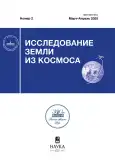Identification of shifts and thrusts of the Yukka-Toksovsky fault zone in the vicinity of St. Petersburg based on remote sensing data
- Авторлар: Nevolin S.N.1
-
Мекемелер:
- OOO “EkspertGaz”
- Шығарылым: № 2 (2025)
- Беттер: 100-112
- Бөлім: ИСПОЛЬЗОВАНИЕ КОСМИЧЕСКОЙ ИНФОРМАЦИИ О ЗЕМЛЕ
- URL: https://bakhtiniada.ru/0205-9614/article/view/306993
- DOI: https://doi.org/10.31857/S0205961425020089
- EDN: https://elibrary.ru/ejxgtc
- ID: 306993
Дәйексөз келтіру
Аннотация
The structural features of the Yukki-Toksovskaya zone of strike-slip faults are considered. The results of the analysis of satellite images of the Yukki-Toksovskaya zone allow us to take a different look at the latest tectonics and geology of the area. The materials show a lens-shaped shear zone, which is atypical for the platform area. Inside the fault zone, bodies of giant tectonic breccia are mapped in the form of rhombohedrons, which are uncharacteristic for this area. The Yukki-Toksovo zone has been studied using structural analysis methods at the level of axial fault zones and fault planes. A description is given of the outcrops located on the fault axes or their wings. The kinematic types of faults are justified by studying the position of thrusts on their wings. A spectral seismic profile across a seismogenic scarp and one of the faults is presented. The magnitudes of vertical and horizontal movements along faults were measured based on the displacement of rocks of the marker horizon. Vertical fault planes have been studied and their genetic connection with thrust faults has been revealed as the development of a single shear zone. Zones of shear failures of several types were discovered. Shifts and thrusts have been identified in the near-surface part of the section of Upper Quaternary deposits. The faults of the Yukki-Toksovo zone are defined as left-lateral strike-slip faults. A preliminary assessment of the velocities of horizontal movements along the faults of the Yukki-Toksovo zone has been made. It is proposed to use the territory of the Yucca-Toksovo fault zone as a testing ground for studying Holocene paleoearthquakes.
Авторлар туралы
S. Nevolin
OOO “EkspertGaz”
Хат алмасуға жауапты Автор.
Email: geonec@yandex.ru
St. Petersburg, Russia
Әдебиет тізімі
- Voronov P.S. Shifts and planetary fracturing // Zap. Gorn. in-ta. 1969. V. 58. Vyp. 2. Pp. 16–26. (In Russian).
- Geodynamic reconstructions. L. Nedra. 1989. 278 p. (In Russian).
- Glikman A.G. Application of spectral-seismic exploration profiling (SSP) for mapping mineral deposits. // Region. geol. and metallogen. 2001. № 13–14. Pp. 34–44. (In Russian).
- Diagnostics and mapping of imbricated-thrust structures: Method. manual. SPb. VSEGEI, 1994. 188 p. (In Russian).
- Kolodyazhny S.Yu., Terekhov E.N., Baluev E.S. Structural and kinematic parageneses and a dynamic model of the evolution of the Baltic-Mezen shear zone in the Phanerozoic, Northwest of the East European Platform // Geotech. 2020. No. 2. P. 48–74. (In Russian).
- Malyasova E.S., Usikova T.V. New data on interstadial deposits of the Leningrad territory // DAN. 1965. Vol. 161. No. 36. P. 1389–1392. (In Russian).
- Nevolin S.N. Detection of active crustal faults in the vicinity of St. Petersburg based on space imaging // DAN. 2015. Vol. 462. No. 2. P. 190–196. (In Russian).
- Nevolin S.N. Identification of paleoseismodislocations in the St. Petersburg area based on remote sensing data // Issled. Zemli iz kosmosa. 2021. No. 3. Pp. 45–54. (In Russian).
- Nikonov A.A., Shvarev S.V. Seismolineaments and destructive earthquakes of the Russian part of the Baltic Shield: new solutions for the last 13,000 years. in the collection: Geological and geophysical environment and various manifestations of seismicity. Mat. Int. conf. edited by VS Imaev. Neryungri: 2015. Pp. 243–251. (In Russian).
- Nikonov A.A. Lateral compression structures in loose sediments in the Northwest of the East European Platform and their interpretation – In the collection: Fundamental problems of the Quaternary: results of the study and main directions of further research. – Proc. X All-Russian. conference on the study of the fourth period. Edited by Yu.A. Lavrushin. Moscow: GEOS. 2017. Pp. 273–276. (In Russian).
- Nikonov A.A. Key areas for a comprehensive study of Holocene paleoearthquakes in the eastern part of the Fennoscandian Shield – methods, parameterization methods, results – In the collection: Fundamental problems of the Quaternary: results of the study and main directions of further research. Proc. of the 10th All-Russian conference on the study of the fourth period. Edited by Yu. A. Lavrushin. Moscow: GEOS. 2017a. Pp. 276–278. (In Russian).
- Paleoseismology in 2 volumes. Edited by D.P. McCalpin. Translated from English. Moscow: Scientific World. 2011. 560 p. (In Russian).
- Utkin V.P. Shear dislocations and methods of their study. Moscow: Nauka. 1980. 144 p. (In Russian).
Қосымша файлдар









